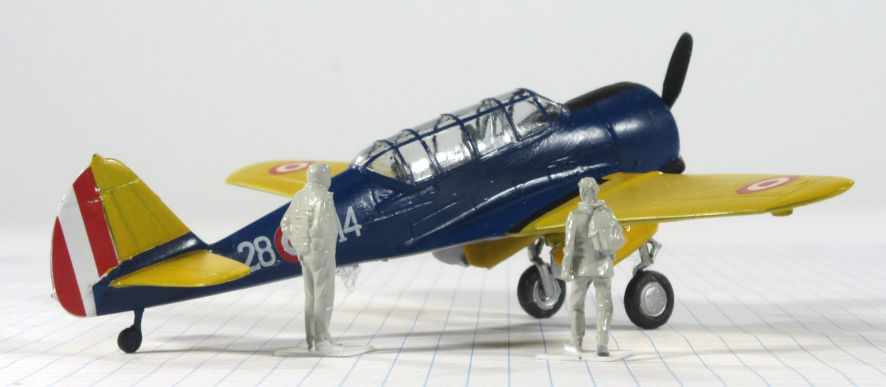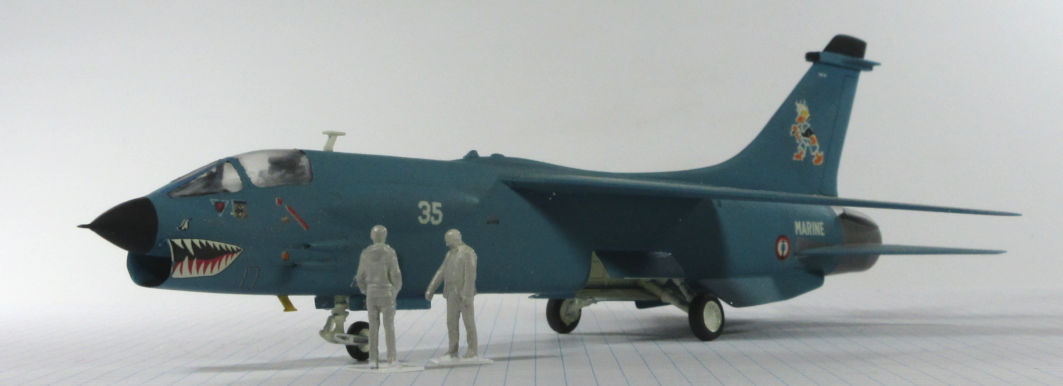US Navy Aircraft in Foreign Service
Curtiss Wright SNC-1 – Lockheed PV-1 – Vought F-8P

If you haven’t noticed, we have a Special Gallery of Aircraft of the US Navy and Marine Corps. There are 33 of them, 45 if you count the aircraft wearing the markings of other nations. The aircraft currently in the collection that flew with the Navy or Marines are on show first, in chronological order, followed by aircraft wearing foreign colours and markings. This week let’s look at three of those aircraft.
Curtiss Wright SNC-1 in 1/72 by Kora Models
This aircraft was a US Navy scout and advanced trainer developed from the Curtiss Wright CW-19 light weight fighter. It had a less powerful engine and a large cockpit for two crew members. It was designed mainly for export and sold to a couple of air forces including the Royal Netherlands East Indies Army Air Force. The US Navy ordered 150 of them in 1940 to help it cope with its rapidly increasing training needs/ They were withdrawn from service in 1946 and some were then passed on to Peru.
Since this is a relatively obscure aircraft there is not much choice of kits with which to make a model of it. There was, according to Scalemates, a resin kit published by RVHP which is little known and this Kora Models kit which has been published in a number of versions since 2017. There is a write up of this kit at the Hangar 47 website, a good description of the aircraft and then a thorough in-box review. It concludes ‘highly recommended’, which shows how misleading this kind of reviewing can be. I’ve written a Workbench Note of my experience with this kit and there you will read that this is not a kit I would recommend to any but hardened and experienced modellers, and only then if they really need a model of this aircraft for their collection. The Modelling Madness reviewer and I are on the same wavelength when it comes to this kit. There’s no denying, however, that the Peruvian blue and yellow colours are rather nice.
Lockheed PV-1 in 1/72 by Minicraft
This aircraft was a militarized version of the Lockheed 18 civil aircraft. It was designed as the replacement for the Lockheed Hudson which was a military version of the Lockheed 14 airliner. It was ordered first by the Royal Air Force as a medium bomber but experience showed it was not suitable in that role in the European theatre. However, it proved more effective in reconnaissance and maritime roles. The Royal Australian Air Force acquired a number of them in 1944 and used them in strike operations against the Japanese north of Australia.
There was a Frog kit of this aircraft first published in 1977 and it has since appeared in a number of other boxings, mainly Eastern European. I haven’t seen one but Frog kits of this period were basic and adequate. More recently – 1987 – Minicraft have published a kit which is still rather basic and lacking most of the detailed features you’d expect in more modern kits. There is a good and thorough review of the kit from which I made this model on the Modelling Madness website. Many years since I bought the Red Roo decal sheet which gives RAAF markings. While doing some light research for this project I found that they are probably based on a restored Australian PV-1, not one in service in 1944. I don’t know if any are decals available for operational aircraft.
The only RAAF squadron in the South West Pacific Area to fly PV-1s was 13 Squadron and Gough Whitlam flew on them as a navigator. (If you don’t know who Whitlam was you are too young.) I tried to find out if he flew on any specific aircraft and what their registrations were, but failed. (If you happen to know don’t tell me, I’d hate to have to strip and repaint this model.)
Vought F-8P in 1/72 by Heller
If you ask me the F-8 Crusader is one of the most elegant aircraft ever manufactured and put into service. They first entered service with the US Navy in 1957 and were finally trtired in 1987. France ordered 42 F-8s, in a modified version of the US Navy’s F-8E as the F-8E(FN), and they began entering service with the Aeronavale in 1964. They were slightly modified for French conditions and revised armament, and upgraded several times during their service. Delays to delivery of the new Dassault Rafale meant that 17 F-8E(FN)s were upgraded with some new systems and designated F-8P (P for ‘Prolongue’) and were finally replaced in 2000.
I’m a sucker for aircraft that look as good as the F-8, have made a few and expect to make a few more. I’ve used the Heller kit for this model. It was first published in 1978 so it’s quite old but I think that the company was at the top of their game when they published this kit and so I collected quite a few of them before more modern kits became available. I thought it was preferable to the Hasegawa F-8 that was published around the same time and on a par with the Ertl/Esci/Italeri kit first published by Ace in 1987. To my mind the Heller kit still makes a very presentable F-8 model, thought I might be tempted to use after-market ejector seats these days. However, if you are new to F-8s the Academy kit is highly regarded and the Modelling Madness and Cybermodeler sites recommend them highly. Only Heller and Academy offer kits of the F-8P, I liked the Heller kit a lot and I have the Academy kit too, which I will get around to making one of these days.



